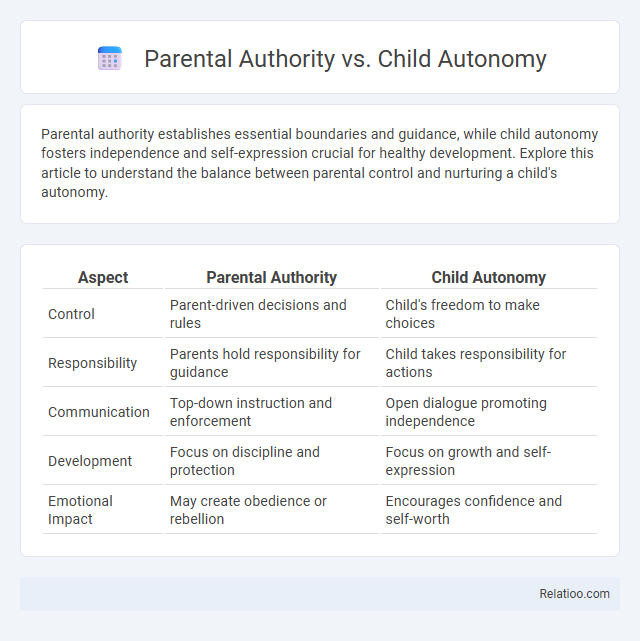Parental authority establishes essential boundaries and guidance, while child autonomy fosters independence and self-expression crucial for healthy development. Explore this article to understand the balance between parental control and nurturing a child's autonomy.
Table of Comparison
| Aspect | Parental Authority | Child Autonomy |
|---|---|---|
| Control | Parent-driven decisions and rules | Child's freedom to make choices |
| Responsibility | Parents hold responsibility for guidance | Child takes responsibility for actions |
| Communication | Top-down instruction and enforcement | Open dialogue promoting independence |
| Development | Focus on discipline and protection | Focus on growth and self-expression |
| Emotional Impact | May create obedience or rebellion | Encourages confidence and self-worth |
Introduction to Parental Authority and Child Autonomy
Parental authority refers to the rights and responsibilities parents hold to guide, discipline, and make decisions in the best interest of their child's development. Child autonomy emphasizes the child's ability to make independent choices, fostering self-esteem, decision-making skills, and personal growth. Balancing parental authority with child autonomy requires respecting individual boundaries to prevent boundary violations that can undermine trust and healthy family dynamics.
Defining Parental Authority in Modern Families
Parental authority in modern families is defined by a balance between guiding children's development and respecting their growing autonomy, creating a framework that supports healthy decision-making and emotional growth. Your role involves setting clear, age-appropriate boundaries that foster independence while preventing boundary violations, which can lead to mistrust or rebellion. Effective parental authority adapts to cultural shifts and individual child needs, emphasizing communication, mutual respect, and consistent enforcement of family rules.
Understanding Child Autonomy and Its Importance
Understanding child autonomy involves recognizing a child's growing capacity to make informed decisions and express individuality within safe limits. Supporting autonomy fosters self-confidence, critical thinking, and emotional resilience, crucial for healthy development. Establishing clear boundaries ensures respect for parental authority while promoting independence, preventing boundary violations that can harm trust and child wellbeing.
Historical Perspectives on Parent-Child Relationships
Historical perspectives on parent-child relationships reveal shifting balances between parental authority, child autonomy, and boundary violations. Traditional societies largely emphasized parental authority, viewing children as dependents requiring strict guidance, while modern views increasingly recognize children's autonomy and rights. Understanding these evolving dynamics helps you navigate contemporary debates on appropriate boundaries and respect within families.
Balancing Control and Independence at Different Ages
Balancing parental authority with a child's autonomy requires adapting control levels to developmental stages, ensuring children gain independence while respecting necessary boundaries. Younger children benefit from clear, consistent rules to create a secure environment, whereas adolescents need gradual freedom to develop decision-making skills, fostering responsibility without crossing boundary violations. Your role involves monitoring boundaries closely while progressively granting autonomy to support healthy growth and mutual respect.
Cultural Influences on Authority and Autonomy
Cultural influences significantly shape parental authority and child autonomy, determining the acceptable balance between guidance and independence in different societies. In collectivist cultures, parental authority typically dominates to maintain family cohesion, while individualistic cultures prioritize child autonomy to foster personal development. Understanding these cultural contexts helps you navigate boundaries and respect varied expectations of authority and autonomy without violating them.
Legal Rights: Parents vs. Children
Parental authority legally grants parents the right to make decisions on behalf of their minor children, encompassing education, healthcare, and welfare. However, children's legal rights to autonomy grow with age and maturity, recognized through doctrines such as the "mature minor" rule and emancipation provisions. Understanding the balance between upholding parental authority and protecting a child's autonomy is crucial to avoid boundary violations that may lead to legal disputes or child protection interventions affecting Your family dynamics.
Navigating Conflicts Between Parents and Children
Navigating conflicts between parents and children requires balancing parental authority with respect for child autonomy while establishing clear boundaries to prevent boundary violations. Effective communication strategies and mutual understanding help address power dynamics, allowing children to express individuality without undermining parental guidance. Setting consistent, age-appropriate limits supports healthy development and fosters trust, minimizing family conflicts and promoting emotional well-being.
Benefits of Supporting Child Autonomy
Supporting child autonomy fosters critical thinking, self-confidence, and emotional resilience, empowering your child to navigate complex social and personal challenges effectively. Research indicates that children with autonomy-supportive parents exhibit higher academic achievement and better psychological well-being due to increased intrinsic motivation. Encouraging independence within clear boundaries prevents boundary violations, maintaining a healthy balance between parental authority and child freedom.
Strategies for Harmonizing Authority with Autonomy
Effective strategies for harmonizing parental authority with child autonomy involve establishing clear communication channels that respect the child's individuality while maintaining appropriate boundaries. Implementing collaborative decision-making processes empowers children to express their opinions and fosters mutual trust, reducing the risk of boundary violations. Consistent enforcement of agreed-upon rules ensures a balanced environment where autonomy is nurtured without undermining parental guidance.

Infographic: Parental Authority vs Child Autonomy
 relatioo.com
relatioo.com